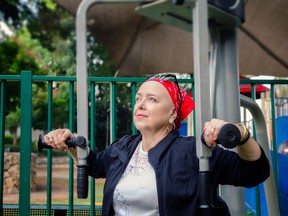Health
Exercise Shown to Slow Breast Cancer Growth, New Study Reveals

A recent study has demonstrated that a single session of exercise can significantly inhibit the growth of breast cancer cells. Published in the previous month, this research involved 32 women who had survived breast cancer. The findings indicate that engaging in high-intensity interval training or weightlifting elevates levels of specific molecules in the blood, which then suppress the development of laboratory-grown cancer cells.
Robert Newton, deputy director of the Exercise Medicine Research Institute at Edith Cowan University in Perth, Australia, led the study and emphasized the direct impact of exercise on cancer biology. “Our work shows that exercise can directly influence cancer biology, suppressing tumor growth through powerful molecular signals,” he stated. This research contributes to a growing body of evidence suggesting that physical activity not only reduces the risk of developing cancer but also enhances the survival rates of those already diagnosed.
The new study provides insights into the specific types of exercise that may be most effective in combating malignancies. Previous research has suggested that cancer survivors who maintain high levels of physical activity tend to have lower recurrence rates. Jessica Scott, director of the Exercise-Oncology Program at Memorial Sloan Kettering Cancer Center in New York City, noted, “We know from large, observational studies that breast cancer survivors who report higher levels of physical activity have lower rates of recurrence and better survival.”
In a related study published in June 2023 in the New England Journal of Medicine, colon cancer survivors who participated in a structured exercise program showed a 37 percent reduction in recurrence rates compared to those who did not exercise. This correlation raises questions about the underlying mechanisms by which exercise aids in cancer recovery.
Research indicates that when muscles contract during exercise, they release various hormones and biochemicals, known as myokines, into the bloodstream. These myokines have been suspected of having anti-cancer properties. In prior studies involving healthy individuals and animals, blood samples taken post-exercise demonstrated a capacity to kill or inhibit cancer cell growth.
To explore these dynamics further, Newton and his team focused on women who had completed treatment for breast cancer and were medically cleared to begin exercising. The participants were divided into two groups: one engaged in high-intensity interval training while the other performed weightlifting. After each session, blood samples were collected to analyze the effects on cancer cells in the laboratory.
The results were compelling. Blood plasma collected post-exercise demonstrated a marked ability to suppress cancer cell growth, particularly from those who participated in interval training. The plasma contained elevated levels of IL-6, a protein linked to immune response and inflammation. The findings revealed that higher concentrations of IL-6 correlated with greater inhibition of cancer cell proliferation.
Newton explained that these results illustrate the multi-faceted benefits of exercise for cancer survivors. “Exercise doesn’t just improve fitness and well-being,” he noted. “It also orchestrates a complex biological response that includes direct anticancer signals from muscles.”
The implications of this study are significant, as they may help clarify findings observed in other cancer types, such as colon cancer. Nonetheless, the question of which types of exercise yield the best outcomes remains. Newton expressed skepticism regarding the efficacy of less intense forms of exercise, stating, “The stronger the exercise stimulus, the greater the release of anticancer myokines.”
Although gentler activities may have some benefits, the study indicated that high-intensity exercise produced the most pronounced effects. Newton also highlighted the importance of resistance training, suggesting that increasing muscle mass through such activities could enhance the body’s release of myokines.
Despite concerns that cancer survivors may struggle with rigorous workouts, Newton affirmed that participants in the study tolerated the exercise well. Scott reinforced this sentiment, stating, “Our group, and others, have shown that tailored, progressive exercise training programs that include high-intensity interval training are both safe and beneficial for breast cancer survivors.”
For cancer survivors considering exercise, it is advisable to consult with their oncologist and explore local programs specifically designed to assist individuals navigating cancer recovery. The positive takeaway from this study is clear: regular physical activity can serve as an accessible and effective strategy to improve health and potentially reduce the risk of cancer recurrence.
Newton summarized the key message succinctly, stating, “Exercise is not just a nice add-on to conventional therapies like chemotherapy or radiation. It’s increasingly being recognized as a first-line treatment in its own right for people with cancer.”
-

 Science3 months ago
Science3 months agoToyoake City Proposes Daily Two-Hour Smartphone Use Limit
-

 Top Stories3 months ago
Top Stories3 months agoPedestrian Fatally Injured in Esquimalt Collision on August 14
-

 Health3 months ago
Health3 months agoB.C. Review Reveals Urgent Need for Rare-Disease Drug Reforms
-

 Technology3 months ago
Technology3 months agoDark Adventure Game “Bye Sweet Carole” Set for October Release
-

 World3 months ago
World3 months agoJimmy Lai’s Defense Challenges Charges Under National Security Law
-

 Lifestyle3 months ago
Lifestyle3 months agoVictoria’s Pop-Up Shop Shines Light on B.C.’s Wolf Cull
-

 Technology3 months ago
Technology3 months agoKonami Revives Iconic Metal Gear Solid Delta Ahead of Release
-

 Technology3 months ago
Technology3 months agoApple Expands Self-Service Repair Program to Canada
-

 Technology3 months ago
Technology3 months agoSnapmaker U1 Color 3D Printer Redefines Speed and Sustainability
-

 Technology3 months ago
Technology3 months agoAION Folding Knife: Redefining EDC Design with Premium Materials
-

 Business3 months ago
Business3 months agoGordon Murray Automotive Unveils S1 LM and Le Mans GTR at Monterey
-

 Technology3 months ago
Technology3 months agoSolve Today’s Wordle Challenge: Hints and Answer for August 19









